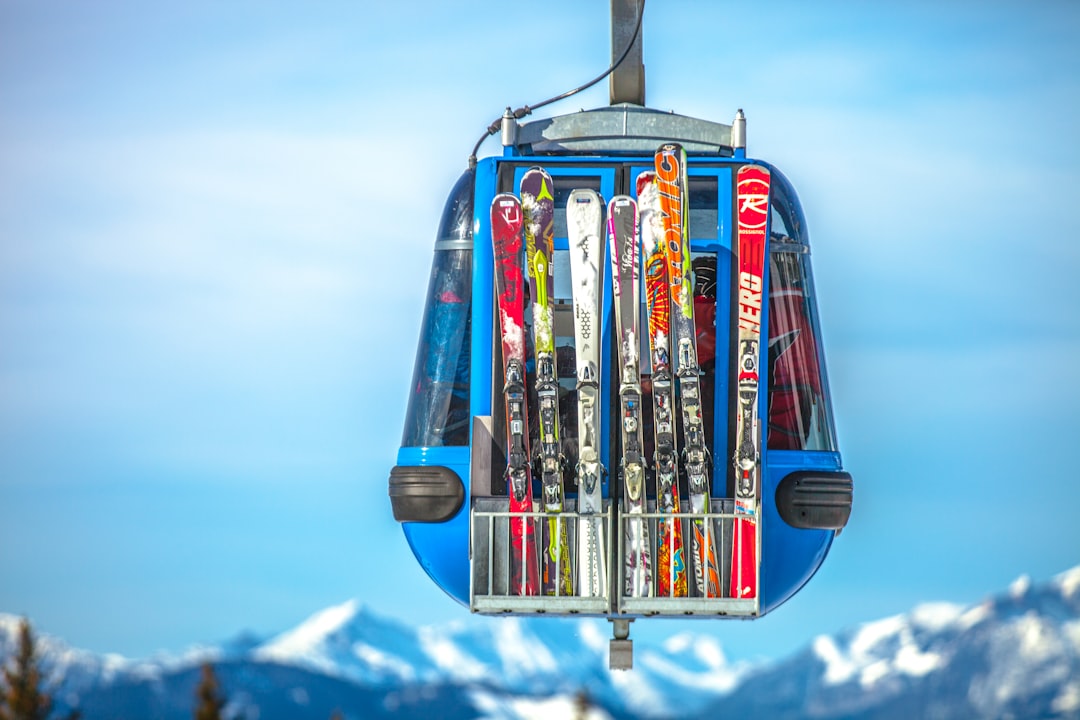The Hidden Carbon Cost of Your Dream Ski Trip
The Hidden Carbon Cost of Your Dream Ski Trip - Planes, Trains, and Automobiles - Emissions Add Up Fast
Getting to your dream ski destination inevitably involves transportation that burns fossil fuels and emits greenhouse gases. While road trips in the family SUV or minivan may seem nostalgic, the reality is that auto emissions can add up quickly, especially when your journey involves hundreds of miles.
According to the EPA, an average passenger vehicle emits about 4.6 metric tons of carbon dioxide per year. So driving 500 miles to your ski vacation would add nearly 1 metric ton of emissions to the atmosphere per vehicle. Even carpooling doesn't solve the problem, it just divides the emissions among more people.
And if you're flying to your destination, look out - air travel is one of the most carbon-intensive modes of transport. Each passenger on a 500 mile flight generates over 200 kilograms of CO2 according to ICAO. With four family members, that adds up to nearly 2,000 extra pounds of greenhouse gases!
Of course, for many skiers, traveling by air is the only practical way to reach far-flung mountain resorts. But it's important to be aware of the climate impact. Frequent flyers trying to reduce their carbon footprint should consider purchasing carbon offsets and supporting programs like Sustainable Travel International that promote sustainable tourism.
Even getting around your destination creates emissions. Airport shuttles, taxis, rental cars, and public transit all run on fossil fuels. Resort transportation like shuttle buses and snowcats are also gas-guzzlers. Some forward-thinking resorts are adding electric vehicles to their fleets, but progress is slow. Until all ground transport is electrified, getting to the slopes will keep incurring a carbon cost.
What else is in this post?
- The Hidden Carbon Cost of Your Dream Ski Trip - Planes, Trains, and Automobiles - Emissions Add Up Fast
- The Hidden Carbon Cost of Your Dream Ski Trip - Lodging's Large Footprint - Energy Use at Resorts and Hotels
- The Hidden Carbon Cost of Your Dream Ski Trip - Chairlifts and Snowcats - The Cost of Mountain Operations
- The Hidden Carbon Cost of Your Dream Ski Trip - Après-Ski Activities - Carbon from Partying and Dining
- The Hidden Carbon Cost of Your Dream Ski Trip - Gear and Equipment - Producing and Transporting All Those Skis
- The Hidden Carbon Cost of Your Dream Ski Trip - Food Imported From Afar - The Mileage on Your Meals
- The Hidden Carbon Cost of Your Dream Ski Trip - A Warming Climate - How Skiing Contributes to The Problem
- The Hidden Carbon Cost of Your Dream Ski Trip - Offsetting Your Impact - Ways to Reduce Your Carbon Footprint
The Hidden Carbon Cost of Your Dream Ski Trip - Lodging's Large Footprint - Energy Use at Resorts and Hotels
Après-ski is great, but where you lay your head after a long day on the slopes has a big climate impact too. Ski resort accommodations like hotels and condos gobble up energy to keep guests comfortable. Heating, cooling, lighting, cooking, laundry - it all adds up.
According to the U.S. Energy Information Administration, lodgings account for about 7% of commercial energy consumption nationwide. For ski resorts, that figure is likely even higher. Unlike tropical beach destinations, mountain regions have long, frigid winters that require constant climate control indoors.
Keeping guest rooms warm and toasty can be hugely energy intensive. Some ski resorts still rely on oil or propane boilers for heating, while newer properties use electric heat pumps. But both produce greenhouse gas emissions, either directly on-site or upstream at the power plant. Hot water heating and cooling for pools and spas also burn through fossil fuels.
Meanwhile, electricity powers the lights, appliances, and electronics that travelers demand. Giant flat-screen TVs, mini-fridges, gaming systems - today's upscale hotel rooms and condo rentals are energy hogs. One 2018 study found that a typical hotel room draws around 50 kilowatt-hours per day - equivalent to the average daily electricity use of 2.4 U.S. homes!
And at ski resorts, outdoor lighting on pathways and parking lots runs through the night to accommodate late-night partiers. All those lumens add up to higher utility bills and more emissions.
Of course, guests expect a comfortable stay with all the modern conveniences. But there are ways lodging operators can reduce their climate impact. Eco-conscious hotels are adding solar panels, geothermal heating, LED lighting, and energy-saving appliances. Some properties pursue LEED or Green Key certification to benchmark sustainability.
But progress is uneven. Large resort companies like Vail are leading the way. Yet many smaller independents lack the financing to make major green upgrades. Until climate-friendly technology is standardized across the industry, lodging's outsized energy appetite will keep imposing a carbon cost at ski resorts.
The Hidden Carbon Cost of Your Dream Ski Trip - Chairlifts and Snowcats - The Cost of Mountain Operations

Getting skiers and snowboarders up the mountain takes a lot of energy. Chairlifts and snowcats keep resorts running, but these workhorses of mountain operations burn through fossil fuels and emit greenhouse gases.
Let's start with chairlifts, which shuttle enthusiastic powder hounds up the slopes. These iconic features define the ski resort experience, offering stunning alpine vistas alongside transportation. Yet behind the bucolic image, chairlifts have a climate impact.
Lift motors require electricity to turn the bullwheel and power chairs up the line. For a mid-sized resort with 25 lifts, this can add up to over 15 million kilowatt-hours per year - equal to the annual usage of 1,200 average U.S. homes! And since most resorts still source electricity from fossil fuels, more emissions result.
Bigger resorts are getting creative to green their lifts. Some like Aspen have installed solar panels on lift towers to generate clean energy. Others like Crystal Mountain are upgrading to more efficient motors to reduce electrical load. But there's still further to go - many aging lifts run on outdated, inefficient equipment in need of upgrades.
Then there are snowcats, which groom the slopes each night. These bulky tracked vehicles use diesel engines to push, tiller, and compact snow into smooth corduroy. Snowcats may boast old-timey charm, but their engines spew soot and greenhouse gases.
For a large resort with a fleet of 25 cats, nearly 50,000 gallons of diesel fuel can be consumed per season. That's equivalent to the carbon emissions from driving 600,000 miles in a typical passenger car.
Some resorts are taking steps to modernize their cat operations, such as using biodiesel fuel blends or testing electric models. But the industry's heavy reliance on diesel persists. Battery-powered snowcats remain rare due to range limitations in cold conditions.
The Hidden Carbon Cost of Your Dream Ski Trip - Après-Ski Activities - Carbon from Partying and Dining

After an exhilarating day hitting the slopes, skiers love to unwind with some apres-ski revelry. From cafes and pubs to dance clubs and dinner spots, mountain villages offer plenty of options. But the partying comes at a climate cost.
Eating and drinking out while on vacation has a much larger carbon footprint than normal at-home meals. Restaurant visits use more energy for cooking, refrigeration, lighting, heating - and let's not forget all those TVs blaring sports and music.
A 2018 study found restaurant meals generate nearly twice the emissions of home-cooked food. So that queso dip, burger, and craft brew you're chowing down on the deck at the base lodge likely comes with a hefty side of carbon.
Nightlife venues like bars, clubs, and concert halls are even bigger energy hogs. They stay open late, blast music, and use effects like strobe lights that suck power. One university study found bars, nightclubs, and lounges had the highest energy use intensity per square foot of any commercial building type in Los Angeles.
And ski resort nightlife often centers around outdoor events like concerts, beer gardens, and bonfires - meaning heat lamps, stage lighting, and other equipment running for hours despite the frigid mountain air. An evening of epic après-ski fun translates into loads of emissions.
Then there's the issue of over-indulgence. From all-you-can-eat buffets to boozy multi-resort pub crawls, ski vacations present constant temptation to overdo it. And excessive food and alcohol consumption exacerbates environmental impacts.
Wasted food that gets tossed rather than eaten accounts for a significant chunk of emissions from dining out. Plus intoxicated patrons are less likely to make eco-conscious choices about transportation, energy use, and waste disposal while partying.
Does this mean skiers seeking après-ski fun are doomed to rack up a massive carbon tab? Not at all. There are ways to be more responsible while still enjoying yourself: stick to pubs not nightclubs, go sledding under the stars instead of concerts, split one entree when you dine out, use public transit not cabs. The planet will thank you, even as you toast another epic ski day.
The Hidden Carbon Cost of Your Dream Ski Trip - Gear and Equipment - Producing and Transporting All Those Skis

All those brightly-colored boards, boots, poles, goggles, and technical outerwear filling ski resort base areas don’t just appear from thin air. Manufacturing, distributing, and transporting ski gear and apparel comes with an often-overlooked climate cost.
Let’s start with skis, since they’re the heart of the sport. Contemporary skis are technological marvels, precision-engineered from a mix of materials like wood cores, fiberglass, carbon fiber, aluminum, and polymers. But building them is energy-intensive. Kilns and autoclaves used in ski construction run on natural gas or electricity. Chemical coatings and paints involve extraction and refining of petroleum feedstocks.
According to one life cycle analysis, the carbon footprint of a typical pair of all-mountain skis equals driving 230 miles in a standard car. For a dedicated park rat who burns through multiple pairs per season, those emissions can really add up. Efforts by brands like Faction to build sustainability into manufacturing help, but remain an exception in this gear-obsessed sport.
Then there’s the long journey gear takes from factory floor to chairlift line. Much ski equipment made today comes from factories in Asia and Europe. Shipping via transoceanic container vessels and diesel-burning trains or trucks tacks on more emissions. Domestic transportation within North America’s sprawling supply chains generates further greenhouse gases.
By one estimate, transport now accounts for 11% of ski gear's carbon footprint - a significant slice. Some manufacturers are addressing this by consolidating production close to resorts. For example, Colorado-based Wagner moved ski building back to the U.S. in 2020 after years of offshore production. Others like Armada and Renoun still rely predominantly on Asian manufacturing.
When all aspects of sourcing materials, manufacturing, and distribution are tabulated, a single pair of skis can generate over 100kg of CO2 before ever hitting the slopes. For an avid skier with quiver of 5-10 pairs, that’s a sizable carbon investment.
And it doesn’t end once gear reaches resorts. The proliferation of demo fleets and seasonal rentals means equipment must be shuffled around constantly to satisfy demand. Turnover and reuse help minimize waste. But shipping skis, boots, and poles from resort to resort each season incurs more carbon costs.
The Hidden Carbon Cost of Your Dream Ski Trip - Food Imported From Afar - The Mileage on Your Meals
The travel required to get food and drink to ski resorts adds significantly to their carbon footprint. From wine poured in slope-side restaurants to burger beef raised on distant ranches, much resort cuisine is imported over long distances – and all that transportation adds emissions.
For example, Colorado is famous for its craft beers. But the malting barley used in beer production often comes from farms in Idaho, Montana, or Canada. That barley then travels to industrial breweries for processing and canning before distribution to resorts. Each step – growing, malt production, brewing, and shipping – incurs transportation emissions.
The same goes for wine. Globetrotting skiers love sampling vintages from around the world when dining out after a day on the slopes. But whether it comes from Napa Valley vineyards or French chateaus, virtually every bottle has racked up thousands of travel miles before reaching your table.
Then there’s the food itself. Beef for burgers and steaks at lodges frequently comes from massive feedlots in the Great Plains, over a thousand miles away from major resorts. Fresh fruits and vegetables travel even farther, imported from warm winter growing regions in Mexico and California. Fish like salmon is sourced from coastal waters thousands of miles from the mountains.
The average ingredient in a meal travels around 1,500 miles from farm to plate. For ski resorts located far from major agricultural regions, that number is certainly higher. All that freight transport by truck, train, ship, and plane leaves behind a trail of emissions.
Some resorts are getting creative to reduce food miles. For example, Aspen sources produce from nearby Rocky Mountain farms to shrink its carbon footprint. Others like Deer Valley highlight local cuisine and beverages to cut down on transport emissions. But imported ingredients still dominate at many establishments.
The Hidden Carbon Cost of Your Dream Ski Trip - A Warming Climate - How Skiing Contributes to The Problem

A cherished winter pastime, alpine skiing sees millions flocking each year to snow-covered peaks for adrenaline, socializing, and fresh mountain air. Yet the sport also contributes to the climate crisis threatening its very existence. Warming global temperatures endanger skiing itself even as resort operations emit greenhouse gases accelerating the meltdown.
It’s a complex dynamic. Skiing relies entirely on specific temperature and precipitation conditions to enable recreation. The period between first snowfall and last melt must be long and consistent enough to open lifts, groom runs, and attract visitors. But as climate change disrupts historic weather patterns, this winter window has narrowed.
One study found the number of days with sufficient snow cover in the western U.S. declined by 34% from the 1980s to 2000s. Higher temperatures are causing more winter precipitation to fall as rain instead of snow. Earlier snowmelt and unpredictable variability now hamper resort operations. Ikon resorts like Squaw and Sugarbush saw opening delays of over a month during the warm, dry winter of 2019-2020.
Such volatility challenges the viability of ski resorts themselves. One estimate predicts roughly half of America’s Northeast resorts could be unprofitable by 2039 as the region gets warmer and wetter. Iconic Colorado destination Aspen has seen snowpack decline 25% since the 1980s. Climate modeling indicates conditions will only deteriorate further in coming decades.
Yet skiing also exacerbates this climate disruption through its own greenhouse gas emissions. All those gleaming lifts, snowcats, hotel rooms, rental SUVs, long-haul flights, factory-made gear, and après-ski parties discussed earlier in this article contribute millions of tons of emissions annually.
While quantifying the sport’s total climate impact remains difficult, one study by Protect Our Winters conservatively estimates skiing currently accounts for 6.5 million metric tons of CO2 worldwide. That’s equal to emissions from nearly 1.4 million passenger vehicles driven for a year.
Clearly, reducing its carbon footprint must be a priority for an industry threatened by warming conditions. Some resorts are stepping up with renewable energy, efficiency upgrades, and sustainability initiatives. But continued progress is needed to align emission reductions with the Paris Agreement targets.
The Hidden Carbon Cost of Your Dream Ski Trip - Offsetting Your Impact - Ways to Reduce Your Carbon Footprint
With skiing's sizable carbon footprint, what can an environmentally-conscious skier do to minimize their impact? While certain emissions like air travel are hard to avoid, there are ways to reduce your carbon tab through offsets and everyday choices.
First, look into purchasing carbon offsets to counterbalance air miles and other unavoidable emissions from your ski trip. Offsets fund projects like tree planting, renewable energy, and methane capture that remove greenhouse gases, offsetting what your travel releases. Quality offset providers like Cool Effect and Terrapass make it easy to calculate and offset your trip's carbon footprint through verified high-impact projects.
For a family of four flying 800 miles roundtrip to a ski vacation, expect to pay around $30-$40 for offsets. Is it perfect? No - some argue offsets allow travelers to keep polluting without changing behavior. But for now, they're a simple way to take responsibility for your impact.
Also try minimizing overall air mileage through nonstop flights and avoiding connections. Fly direct if you can, even if it costs a bit more. And consider ground transport like rail as an lower-emission alternative. For regional trips, buses and trains emit around half the CO2 per passenger as flying.
Lodging and dining choices also make a difference. Seek out eco-certified hotels with sustainability programs when booking your stay. Energy-efficient properties use less power overall. And choose restaurants serving local food and drinks to reduce emissions from long-haul transport and shipping.
Using public transit like shuttles and buses rather than taxis and rental cars to navigate the resort cuts emissions, as does sharing rides with other skiers when possible. And skip the private snowcat tours - while awesome, these fuel-gulping expeditions rack up major emissions per person. Stick to lifts and group lessons.
Voting with your wallet also sends a message. Support ski brands taking steps to reduce their climate impact through manufacturing, materials sourcing, and distribution. And when upgrading your gear, consider purchasing used equipment instead of brand new whenever feasible. Reuse beats recycling for carbon savings.
At the resort, make full use of your gear instead of needing rentals each trip - one set of skis used for years emits far less than disposable demo rentals every visit. And gear up with natural fabrics like wool instead of petroleum-based synthetics, which have a heavy manufacturing footprint.
Finally, get involved in climate advocacy groups like Protect Our Winters which lobby resorts and government to enact meaningful emissions reductions in the industry. Achieving systemic change through policy remains the most powerful way to combat skiing's impact.
